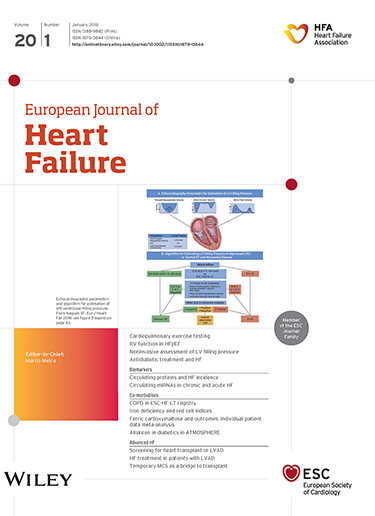心房心肌病:从健康心房到心房衰竭。ESC心力衰竭协会的临床共识声明
IF 10.8
1区 医学
Q1 CARDIAC & CARDIOVASCULAR SYSTEMS
引用次数: 0
摘要
心房心肌病(AtCM)作为一种特殊的临床实体的重要性日益得到认可。过去的定义各不相同,并且缺乏一致的成像参数和生物标志物的切断,限制了诊断和跟踪AtCM进展的临床应用。虽然研究主要集中在心房颤动背景下的AtCM,但新出现的证据强调了其在心力衰竭的重塑和发展中的相关性。本共识文件的目的是为AtCM提供一个当代框架,为更广泛的临床应用发展AtCM和心房衰竭的定义,并帮助指导新兴研究和未来的临床试验。支持早期职业研究人员的工作,该共识文件评估了诊断标志物,并总结了AtCM的基本机制、临床特征和预后影响。我们的目标是汇集新的转化科学进展,催化未来的研究,使临床应用能够促进更好的管理,例如,在积极控制风险因素或合并症的患者群体中,可以预防AtCM的进展。我们将AtCM重新定义为一种分级疾病,包括心房电功能障碍以及机械性心房功能障碍、心房增大和/或心房纤维化的证据。心房衰竭是AtCM的终末期表现,以进行性结构、电生理和功能改变为特征。早期识别、风险分层和正在进行的治疗选择研究有可能预防AtCM和心房衰竭的临床后果,包括与心房颤动和心力衰竭相关的不良患者结局和生活质量差。本文章由计算机程序翻译,如有差异,请以英文原文为准。
Atrial cardiomyopathy: From healthy atria to atrial failure. A clinical consensus statement of the Heart Failure Association of the ESC
The importance of atrial cardiomyopathy (AtCM) as a specific clinical entity is increasingly recognized. Past definitions have varied, and the lack of consistent cut‐offs for imaging parameters and biomarkers have limited clinical utility to diagnose and track AtCM progression. While research has mainly focused on AtCM in the context of atrial fibrillation, emerging evidence underscores its relevance in remodelling and development of heart failure. The aim of this consensus document was to provide a contemporary framework for AtCM, evolve the definitions of AtCM and atrial failure for more widespread clinical use, and help to direct emerging research and future clinical trials. Supporting the work of early career researchers, this consensus document evaluates diagnostic markers and summarizes the underpinning mechanisms, clinical characteristics and prognostic impact of AtCM. Our objective was to bring together new translational scientific progress, catalyse future research and enable clinical application to facilitate better management, for example in patient groups where aggressive control of risk factors or comorbidities could prevent AtCM progression. We redefined AtCM as a graded disorder that includes electrical dysfunction of the atria along with evidence of either mechanical atrial dysfunction, atrial enlargement and/or atrial fibrosis. Atrial failure is the end‐stage manifestation of AtCM, characterized by progressive structural, electrophysiological and functional changes. Earlier identification, risk stratification and ongoing research into therapeutic options have the potential to prevent the clinical consequences of AtCM and atrial failure, including adverse patient outcomes and poor quality of life associated with atrial fibrillation and heart failure.
求助全文
通过发布文献求助,成功后即可免费获取论文全文。
去求助
来源期刊

European Journal of Heart Failure
医学-心血管系统
CiteScore
27.30
自引率
11.50%
发文量
365
审稿时长
1 months
期刊介绍:
European Journal of Heart Failure is an international journal dedicated to advancing knowledge in the field of heart failure management. The journal publishes reviews and editorials aimed at improving understanding, prevention, investigation, and treatment of heart failure. It covers various disciplines such as molecular and cellular biology, pathology, physiology, electrophysiology, pharmacology, clinical sciences, social sciences, and population sciences. The journal welcomes submissions of manuscripts on basic, clinical, and population sciences, as well as original contributions on nursing, care of the elderly, primary care, health economics, and other related specialist fields. It is published monthly and has a readership that includes cardiologists, emergency room physicians, intensivists, internists, general physicians, cardiac nurses, diabetologists, epidemiologists, basic scientists focusing on cardiovascular research, and those working in rehabilitation. The journal is abstracted and indexed in various databases such as Academic Search, Embase, MEDLINE/PubMed, and Science Citation Index.
 求助内容:
求助内容: 应助结果提醒方式:
应助结果提醒方式:


